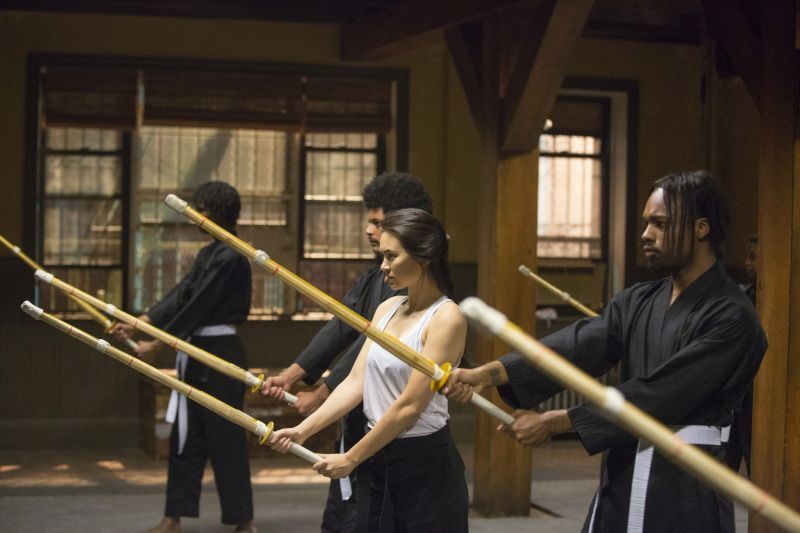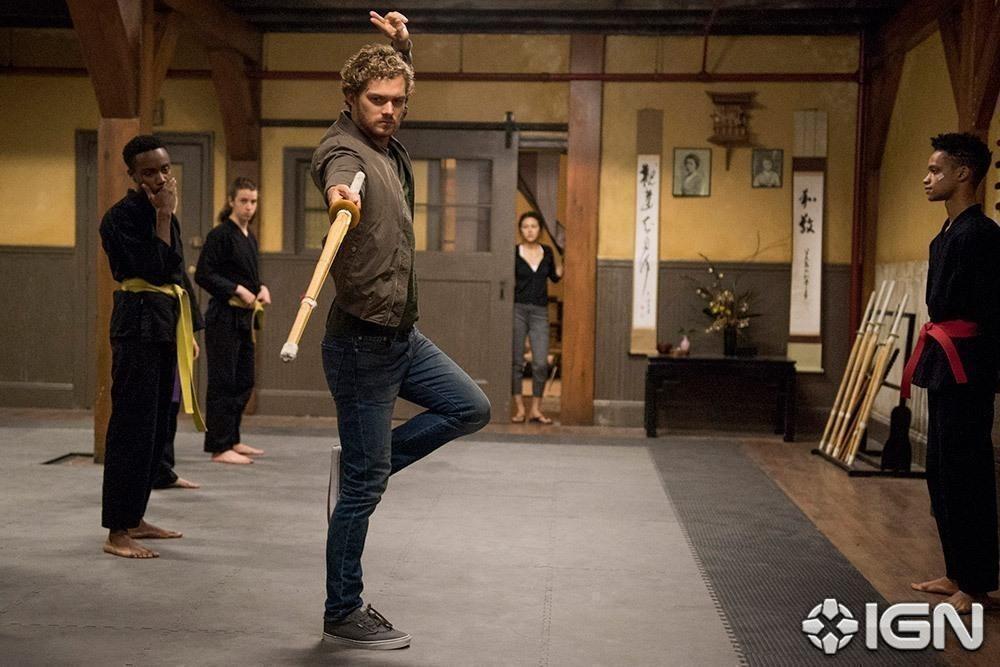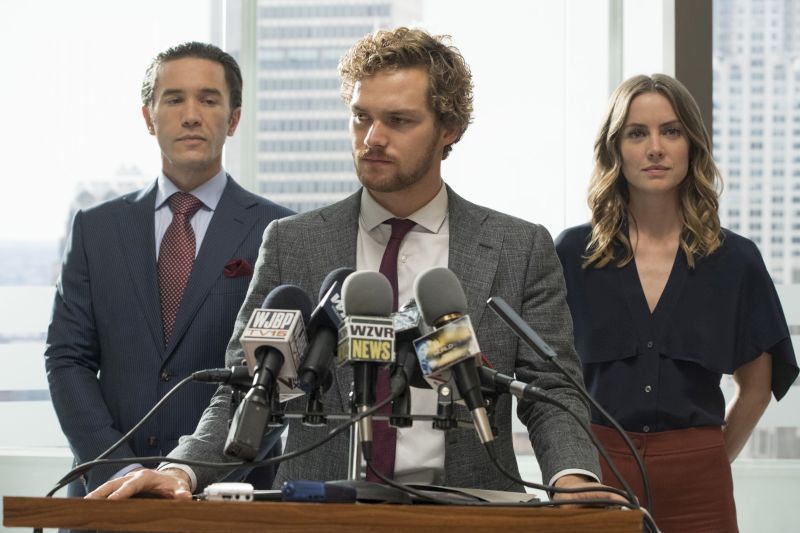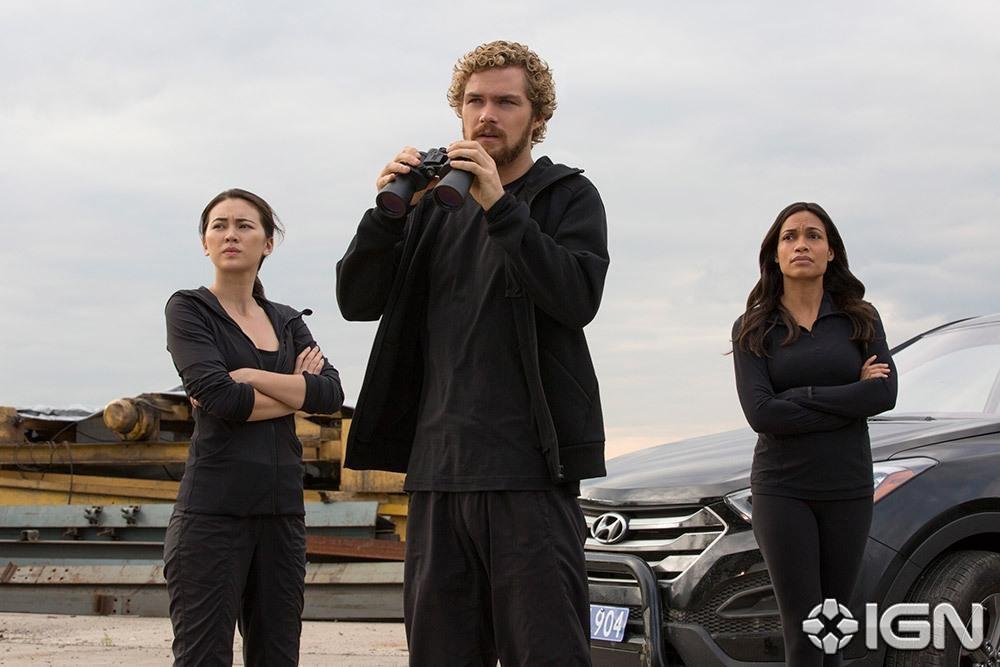I really liked Netflix’s Daredevil, with its high characterization and great street vibe. I thought Jessica Jones was absolutely stupendous with an extremely good writing, great characters, and great acting to match. I was disappointed with Luke Cage; it didn’t meld that “street” vibe found in Marvel’s Netflix shows, including Jessica Jones, with the Blaxploitation genre the showrunners very much wanted to pay homage to in a smooth, enjoyable way, and the story became disjointed with the introduction of a second villain that came out of nowhere. With Luke Cage, the problem was in the writing, but definitely not the acting.
Now we have the fourth, most boring and uninspired of the bunch: Iron Fist.

From Netflix.com
Iron Fist’s Race Thing
Let’s get the race stuff out of the way. Danny Rand, The Iron Fist, is originally a White character built on a story of Asian mystic and martial arts stereotypes. There was some controversy about the casting of the lead, with many Asian Americans hoping Marvel would cast an Asian American actor in the role.
I’m Chinese American, and I’m not offended that they kept Danny Rand as a White man. That’s who he is in the comics, and as interesting as it may have been to make the on-screen character Asian American, from a storytelling and representational standpoint, the character’s story would have to change from the one in the comics. Changing any established character’s ethnicity, gender, or sexuality could or would necessitate a change in story because, were that character to exist in the real world, chances are pretty high they’d have a much different experience than that of whatever their original ethnicity, gender, or sexuality is. Advocates for an Asian American Danny Rand knew that, and offered up an interesting take on a backstory change. As much as I’d like to have seen that, Marvel decided to keep the character they way he is in the comics. I accept their decision. I’ll have to judge what they present to me, should I choose to watch. Which I did.
This brings us to the question of cultural appropriation. Appropriation is taking something for one’s own use. It is neither inherently bad or good; only the results can be bad or good. My take on cultural appropriation is: it happens. Without it, we wouldn’t have: Korean tacos (Korean + Mexian), ramen (Chinese egg noodles in a Japanese dish), K-Pop (Korea meets American teen pop), blues and jazz (African music adapted to western music theory), Brazilian Jiu-Jitsu (Judo and Jiu-Jitsu adopted and adapted by Brazilian Helio Gracie), Jeet Kune Do (a concept conceived by Bruce Lee that borrows from all fighting styles), Cajun food (French colonists from Acadia, Canada influenced by the food in the region they settled in Louisiana), and so much more.
And don’t forget Samurai Jack and the show’s very popular return.
But there’s a difference between good appropriation and bad appropriation. Good appropriation is done with respect to the source. Take Avatar: The Last Airbender, for example. The show’s creators are not Asian, and neither is most of the voice cast. Yet, the story was presented with clear respect for the Asian material from which they borrowed. Bad appropriation is done with disrespect. Take, for instance, the controversial video about a pho restaurant (since taken down) published by Bon Appetit in September 2016.
Iron Fist was born out of stereotypes. I can’t say if any disrespect was intended with the character’s conception. What I can say is that the creation of Iron Fist was a case of Marvel and creators Roy Thomas and Gil Kane being influenced by, and wanting to capitalize on, the oncoming trend of kung fu movies popularized by Bruce Lee. They borrowed stereotypes to present something they thought would be trendy. Other comic creators did the same. This is not inherently bad. Plus, the comic was created in 1974, back when most characters were still being created as White. Not all, but most. Batman. Spider-Man. Iron Man. Iron Fist.
Still, in presenting this story today, Marvel and Netflix must deal with an American society that has heightened its sensitivity towards racial issues, including cultural appropriation. And with Asian Americans wanting more representation in media, it’s easy to see why Netflix’s Iron Fist is oddly timed. Had it come out even five years ago, it might not have been quite as weird to see White English actor Finn Jones playing Danny Rand. But here, in 2017, it’s weird.
My hope with Netflix’s Iron Fist was that the showrunners would treat whatever Asian elements they use with respect. The result? The show doesn’t necssarily disrespect anything borrowed, but there isn’t really a lot of reverence, either. Anything Asian in the show is just kind of… there. Iron Fist presents the viewer with small reminders that there is an Asian context to the story: recurring Netflix/Marvel Asian character Madame Gao, Danny Rand spouting Buddhist philosophies and prayers, lines of Mandarin, and glimpses of monks. Ideally, the Asian elements would be presented in a natural and integral way in order to provide a deeper context. Instead, these reminders come across as superficial, rendering them rather unimportant. This defeats the purpose of having an Asian foundation to the Iron Fist story: A boy gets lost in another land, grows up there learns to fight, and gains a power called The Iron Fist. The Asian part of his origin isn’t explored, merely presented in fragments.
The main exception to this superficiality is Colleen Wing, played by Jessica Henwick. Colleen is a main side character of Chinese (or, at least, half Chinese) descent that is a Karate and Kendo master with her own dojo and her own backstory. The other exception, to a much lesser degree, is The Hand. They’re an influential underground organization that trains their members in martial arts, but they’re not presented as ninja as they are in Netflix’s Daredevil or the comics. In Iron Fist, they’re mainly just tough thugs. So, the obvious thing that ties The Hand to anything Asian is stripped away.

Colleen Wing teaching Kendo to students. Photo via IGN.
I thought I’d have a problem seeing kung fu master monks training Danny and his fellow students – not because of stereotypes, but because that scenario was purposefully avoided for Marvel’s Doctor Strange: The character of The Ancient One was turned into a Celtic/White woman instead of keeping the character a Tibetan man because Marvel didn’t want to perpetuate the Asian guru stereotype. The problem with this is that many stereotypes come from truth. There’s a way to present stereotypes steeped in truth in an honest, respectful, well-developed manner, and there’s a way to portray those same stereotypes as superficial, dumb, mean, laughable, and meaningless. There are deeper reasons why Asians are thought of as smart bookworms and good students, why Asians are typically associated with math and computers. Just as there’s a deeper reason why Chinese martial arts seem mysterious and mystical. Characters and plot devices that might need to fit these stereotypes can be written and presented with reverence.
Spending time with the monks in K’un L’un, the fictional Asian land in which Danny was lost, may have alleviated the problem of superficial Asian elements, but it turns out there are only minor glimpses of the warrior monks in Iron Fist. Nothing like what I thought I’d see. I wonder if the showrunners wanted to avoid Asian guru stereotypes, a la Doctor Strange, or if they’re reserving the monks for a future storyline. Either way, it doesn’t matter. Without them, the story’s connection to Asian culture suffers. The audience doesn’t get a chance to connect with Danny’s origins, his transformation, and the trials he endured during his time in K’un L’un, making him very one-dimensional.
Oh yeah. There’s also the martial arts. That tends to be pretty Asian.
The Martial Arts Of Iron Fist
…are mediocre.
I really like the fight sequences of Netflix’s Daredevil. Raw, powerful, aggressive, well-paced, and visually pleasing. They’re very, very good for what is essentially a TV show. By comparison, though, Iron Fist makes Daredevil look phenomenal.
This is extremely sad because the story of Iron Fist depends so much on martial arts. But the choreography, performance, and the editing are all generally lacking. For example: One early scene depicting a short sparring match between Danny and Colleen is so slow and deliberate that I was instantly reminded of the playground sparring match in writer-director Mark Johnson’s movie version of Daredevil (the much-maligned quality of which I still maintain isn’t Ben Affleck’s fault, but is Johnson’s… but, I digress).
Finn Jones as Iron Fist has no finesse. When shown practicing, he moves as if he’s remembering what to do. He moves a hand, an arm, from Point A to Point B with no intent or purpose. During fight scenes, he poses in kung fu-esque poses, as is customary in martial arts films, but looks ridiculous doing it. And while looks aren’t important in a street fight, looks are super important on-screen. Now, Jones isn’t horrible: he can punch, kick, and throw (or, his stunt double can), but he doesn’t move like he’s at one with his training. He’s unconvincing and cheesy.
As a person that has trained in two different martial arts over several years, I know how difficult it is to remember the training and to be good it. But Finn Jones is an actor. It’s his job to convince the audience that he knows what he’s doing. Other untrained actors have done it long before him. Jason Scott Lee, who placed Bruce Lee in the dramatized biopic, Dragon: The Bruce Lee Story, had some technique problems. But, his physical performance convinced me, visually, that he knew what he was doing. Jones does not do that. He doesn’t sell his character’s skill.
Other actors are more convincing: Sacha Dhawan and Ramon Rodriguez, who play Davos and Bakuto, respectively, both move well and with more finesse. Henwick’s Colleen is pretty good, too. Like Lee in Dragon, there is some physical awkwardness, but she moves powerfully.
Furthermore, Danny practices the same very short Tai Chi-esque form through the entire series, with one or two exceptions as the story necessitates. The layperson likely won’t know this, but most forms in kung fu are much longer, and most, if not all, kung fu styles have several forms or variations on a form depending on the style (I won’t profess to know everything about every kung fu style). Rand practicing a single short form for the entire series does nothing to help show off his level of knowledge.
I’ve read the argument that showing Danny performing a long, slow form would be a waste of time. This argument holds no weight. As we’ve seen in Dragon: The Bruce Lee Story, the Ip Man series, and even the Avatar: The Last Airbender series, among others, giving the illusion of slowness and/or length when showing martial arts forms is entirely possible with creative choreography and editing along with a good performance (or animation, in Avatar‘s case).

Danny strikes a pose. Photo via IGN.
To be fair, according to Jones, he only had 3 intense weeks of martial arts and weight training before filming began, and apparently he had to learn fight choreography 15 minutes before filming – all because filming was on a tight schedule. Thus, he did the best he could, and that is absolutely understandable. Except, the audience won’t know this going in, so it’s irrelevant. If the production team is going to rush through important elements of a show, they’re going to get bad to mediocre results, and Iron Fist‘s team skimping on the martial arts for a show dependent upon martial arts is an idiotic thing to do. Plus, I think that there are things Jones could have done on his own to prepare and be more convincing in his performance. He is, after all, the one on screen.
As for the fight scenes themselves, it’s almost as if the showrunners had never seen a good kung fu film. They use the trendy quick-cut editing style while enveloping many of the scenes in tons of black to try and create a sense of violence in a dark, scary atmosphere… or to make up for the lacking in fight department. Who knows. By comparison, the fights in Daredevil weren’t as dark, and the show is dependent upon night scenes. The darkness was stylized, sure, but we could see much of what was going on, creating a visceral experience while still letting us see how good of a fighter Daredevil is. As a contrary example, Iron Fist features a one-on-one fight in episode 12 that should have been climactic. But, it’s clad in black with shapes of light in the background so we can kind of see the silhouettes sometimes. It was boring. I waited for it to be over. Unfortunately most of the fights in Iron Fist are this boring, regardless of lighting. There are some nice moments, sure, but they’re not enough.
I want to see the fights. I want to see what makes Iron Fist the Living Weapon. There’s a reason why people love films by Bruce Lee, Jackie Chan, Jet Li, and Donnie Yen, among other great martial arts films – because these films show how skilled their stars are, how badass they are. Iron Fist should continue this legacy. After all, the character was created out of the kung fu film genre, so it follows that the show demonstrate that. It fails.
Yes, quick-cut editing can work if done properly. Christopher Nolan’s fight scenes in his Batman trilogy are good examples. The most important thing about quick editing is that it can’t take the place of the content. The content itself must be understood, regardless of the editing, unless the director is purposefully trying to confuse, disorient, or hide something from the audience. If the editing takes the place of the content, the content isn’t important and therefore useless. In the Batman trilogy, we can see what’s going on, even though the cuts are quick. The editing enhances the brutal, violent chaos of the fights. In Iron Fist, the editing, along with the lighting, serve to distract and cover up the content.
The Boring Story Of Netflix’s Iron Fist
I’ll try to review the story without spoiling anything.
Both Daredevil and Jessica Jones were slow, but they were interesting enough that the pacing was comfortable and I could get sucked in to the story. They were, in a way – especially Daredevil – like absurdist plays where not much happens in the way of plot, but we get to know the characters – their personalities, their views, their perceived place in the world. Not so with Iron Fist.
Danny Rand who, at age 10, becomes deserted in the Himalayas after a plane crash left him stranded and his parents dead. He was taken in by monks of K’un L’un, learned their ways, was taught kung fu, and earned the power of the Iron Fist. He’s the sworn enemy of The Hand and the Immortal Weapon that is supposed to guard the opening of K’un L’un. He returns home to New York after 15 years of being presumed dead.
For much of the series, we don’t really know why Danny returns home, but it doesn’t appear for the sake of finally returning to America or for the sake of reclaiming his family’s company, Rand Enterprises. It’s safe to assume that he wants to learn more about his parents’ death because he is fixated on it, and, for some reason, he believes there was more to the plane crash than what meets the eye. Why he believes this is never really discussed. What we can figure, though, is that he may not have come home to hunt The Hand, since he learns after his return that The Hand is also in New York. Convenient, no?
The plot is thin, which is fine so long as the presentation is captivating. It’s not. Most developments that take place are not suspenseful, surprising, or the least bit interesting. Conversations between characters linger without going anywhere significant. Character personalities are very easy to determine almost right away, and their place in the world is obvious and simple. There are a couple complex characters as we find out during the series, but it is a chore waiting to get these points. There are so many unmoving, uninteresting scenes that the 13 episodes could have likely been distilled into six or seven episodes and not too much would have been lost. I found myself getting through episodes out a sense of duty, not a sense of anticipation and excitement.
There are many moments of camp and cheese, even though the show doesn’t seem to be built for it. Sometimes it’s the dialogue, sometimes the acting, sometimes both. When Danny talks to Colleen’s students while she’s out of the dojo, he emphatically delivers the philosophies of a disciplined warrior, then proceeds to demonstrate by performing moves in an amateurish fashion. I cringed as I watched, and the students laugh at him. In another scene, Danny and Collen practice Danny’s one form together, but then she turns to face him and they mirror each other in what I assume was supposed to be a romantic martial arts dance. It wasn’t lovely or sensual, and there was no connection between the two. It was campy.
The Characters Of Iron Fist

Danny Rand, Ward Meachum, and Joy Meachum. Photo via IGN.
When we meet Danny, he’s a good-natured guy with inner conflicts. He tries to follow the Buddhist teachings of the monks, but often fails or contradicts them. He is full of anger and has difficulty quashing those feelings with meditation. The American in him is often at odds with the monk lifestyle; after regaining his wealth, he’s seen driving around in an Aston Martin, one of the most expensive supercars on the market (the show makes a joke about this, which is pretty funny).
He doesn’t seem too clever, either. He may have been immersed in another culture for 15 years, but he left America at age 10, so surely he should have some inkling that telling people – say, a psychiatrist – about K’un L’un and his role as The Iron Fist might not be taken seriously; after failing multiple times trying to prove his identity to his friends, Ward and Joy Meachum, it took him an annoyingly long time to seek help; he’s rather petualantly impulsive, going out on missions without any real idea of what to do other than fight.
Finally, he continually reminds the audience, with much earnest, that HE IS THE IRON FIST and sworn enemy of The Hand, like he’s also trying to remind himself.
These are small details that culminate into the makeup of his character, and anyone would think that a character with these complex set of traits would be interesting. But, for some reason, he’s not. After we learn whatever the show wants to reveal about him, he stagnates. There is very little development. But, if Danny Rand is meant to be a brash, naïve, grown-up child of relative innocence, then Jones’ portrayal fits the bill.
Colleen Wing is interesting. It’s obvious there’s more to her story than just being a teacher helping out troubled youths. We learn about her little by little, but as things are revealed other questions arise. Compare this to Danny, about whom there are the same questions after each episode: Why did he leave K’un L’un? How did he get the Iron Fist? Why does he suspect foul play with his parents’ death?
There’s the Meachum family, close friends of the Rands. When we meet Ward Meachum, it’s easy to assume he might be the main villain. He spent his entire life under the psychologically abusive control of his father and spends the series trying to find a way to escape it. His character, who himself displays a slightly abusive, authoritarian demeanor, flip flops on a few plot elements but ultimately and selfishly tries to do the right thing, both for his sister Joy and himself. His character shows some development through the series and seems to come out a changed man by the end. Joy, however, is kind of a MacGuffin, a plot device that helps move things along but isn’t necessarily important herself. She serves as the person Ward cares about the most, and the person Danny feels most connected to upon his return home until that connection is cast aside. Her character seems to serve other characters’ stories.
Harold Meachum, the father, is also a plot device. He gives Danny some sort of purpose, at first. His character is shrouded in mystery, but once the mystery comes to light his story becomes predictable. He undergoes very little development and, like Joy, merely serves as a means of deepening Ward’s character.
There are a few notable side characters. We learn more about Madame Gao, an elderly Chinese woman played by Wai Ching Ho that was introduced in Daredevil, and her involvement in The Hand. Davos, Danny’s friend from K’un L’un, considers Danny a brother while hinting at jealousy and/or ulterior motives. The monk Lei Kung, Danny’s primary sifu in K’un L’un (who sounds a bit like Christopher Lee), makes an appearance in a series of visions to provide Danny with some wisdom during a 3-tiered battle a la Bruce Lee’s Game Of Death. Carrie-Ann Moss returns to the Netlfix/Marvel franchise as lawyer Jeri Hogarth, who first appeared in Jessica Jones. And Bakuto, an obscure character from the Daredevil comics, makes for a good antagonist: His initial intentions are good, but you can tell there just has to be something he’s hiding.
Then there’s Rosario Dawson’s Claire, a recurring Marvel/Netflix character who made her first appearance in Daredevil, makes a cameo in Jessica Jones, and is a major side character in Luke Cage. She plays arguably important roles in those series, both big and small, but I cannot figure out why she’s in Iron Fist, other than it must be a franchise requirement. She’s a nurse, and in Iron Fist, she’s a student of Colleen’s who decides she going to involve herself in Danny’s adventures. For no reason. She has no personal stake in the story, and no connection to Danny other than Colleen being a mutual acquaintance.
Well, there is the fact that The Hand infiltrated her hospital in Daredevil season 2, during which one of her friends was killed. But, she recalls this in a mere few lines of dialogue. The problem with this is if a character refers to something that happened in another show, but we’re not shown these references in the show we’re watching, and not enough significance is given to the exposition, the reference runs the risk of not having importance. When a character makes very brief mention about something in their past, we can acknowledge something happened, and it may be interesting, but it won’t have much weight other than it gives the character some nuanced background. In Claire’s case, she mentions the hospital attack as an off-the-cuff utterance during a debate about an upcoming mission – minor exposition equals minor information equals minor importance. As a result of this mere utterance, she ends up going on the mission with Danny and Colleen… because she “owes” The Hand, apparently.

Colleen and Danny get ready for action. Oh, and Claire came along. Photo via IGN.
Since she’s there, she gets put to use, patching up wounds and helping in fights – due to her training with Colleen, she can fight. Her skill level is undetermined except we know she’s a student. Yet, she faces off against supposedly dangerous fighters, she doesn’t die, and I don’t recall her getting wounded. I guess this means she’s either on the same level as Danny and Colleen, she was smart enough to pick the least skilled baddies, or she’s just incredibly lucky. I assume the latter. In any case, I’m having a hard time figuring out why Claire is in the show. It could be argued she was important in some way, big or small, in Daredevil, Jessica Jones, and Luke Cage. But this presents another problem: Claire’s character is full if you’ve seen the other shows, but if you only regard her character as presented in Iron Fist, then she has no significance.
The End Of Iron Fist
I’m going to end with the end: I won’t spoil anything, but Danny Rand isn’t even the one who wins in the show’s finale.
There are two major battles at the end of the story, and Danny isn’t the one who triumphs in either. His entire journey – being The Iron Fist, his search for his true purpose outside of K’un L’un, his war with The Hand – is really just a catalyst for other characters’ journeys.
I also realized, during the last couple episodes, that I was watching a B movie that doesn’t realize it’s a B movie. Its teetering between that fine line of cheese and wanting to be taken somewhat seriously that blinds itself to what it really is.
I really need to mention the theme music: If you’ve seen the official Iron Fist trailer, you may have noticed the music, which I thought was pretty good. A medium-paced drum-and-bass feel with a kind of filtered organ ostinato over the top for some drama. The actual theme song of the show pales in comparison to the trailer music. It’s atmospheric but unmemorable and not dramatic or exciting. Of course, the same could be said about the trailer itself being better than the actual show…
Were there any redeeming qualities of Netflix’s Iron Fist? I liked Colleen Wing. And it was nice to see Madame Gao’s role develop a little further. Bakuto and Davos were a decent characters, however minor they turned out to be in this season. And the overall acting isn’t bad, save for Finn Jones’ lack of martial arts prowess. The actors did what they could with the script and production, and you can tell they’re trying to be good at their job.
Perhaps I had a lot to say about Iron Fist because so much that could have and should have gone right just went wrong. In my opinion, of course. We got a show with no heart. This isn’t to say the production team didn’t put any effort into making the show – obviously, there is some – but it just wasn’t the right kind of effort. Plus, if this kind of show – one that is associated with cultural controversy – is going to be made, it had better be done extremely well. I may watch season 2 if and when it comes out, but not because I’m eager to get to the next part of the story. More out of morbid curiosity, to see if another trainwreck happens.
TL;DR
Netflix’s Iron Fist uses Asian elements inherent in the comic character’s story in a superficial manner, rendering them as mere reminders of the context of Danny Rand’s story; there’s nothing deep about them. The martial arts are amateurish, as if the showrunners had never seen a good kung fu movie before. Quick edits and near all-black composition during fight scenes work to their detriment, not to their favor. Finn Jones has no finesse as a actor performing martial arts on screen. The story could have been condensed to six, maybe seven episodes. The story goes mostly nowhere, the plot is thin, and most characters do not develop or are simply tools for other characters’ development.
This article has been updated for clarity. 6-29-2018
